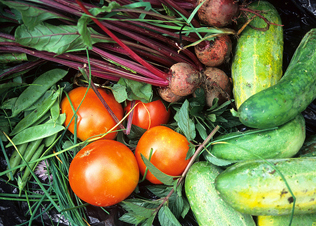News
How to start your own vegetable garden
Wednesday, September 19th, 2012
You don’t need a lot of space to start a kitchen garden – a rooftop terrace, courtyard or lawn will do – but the most important thing is to have the right soil and care. One of the biggest advantages of your own veggie patch is that you get a year-round supply of fresh produce, and there’s the added bonus of being able to grow unusual varieties not available in supermarkets, like broad beans, Jerusalem artichokes, kale, celeriac, salsify and more.
Here are five simple steps to growing your own vegetables and herbs:
· The garden will need at least six hours of sunlight a day to grow vegetables successfully. Some vegetables, like kale, spinach, beetroot and radish, can make do with light shade.
· Well-drained soil must be enriched with plenty of organic matter in the form of compost, vermicompost (compost from worm castings) and manure.
· A pH of around 6.5 is required. (A simple pH metre can be purchased from your nearest garden centre for under R100.)
· Plants need moisture to grow, so be sure to plan your garden around a permanent water source, like a tap, garden hose or rainwater tank).
· Good air circulation is necessary, but windy sites will need some form of protection. Although it’s easiest to start with seedlings, there are many types of vegetables that grow very successfully from scattered seeds, like radishes, peas, beans, carrots, cut-and-come-again salads, spinach and chard.
Important planning tips:
· The best method for growing vegetables successfully is inter-planting. This maximizes the benefits of companion planting, where you grow certain types of plants near to each other to ward off pests and diseases. (See Margaret Roberts Companion Planting for more.)
· The next-best method is to plant the same variety in one space and practice crop rotation. This involves planting vegetables in family groups – brassicas, legumes, roots etc. – and ensuring that each group is not grown in the same bed for at least three years.
· If you have limited space or find it difficult to work out a rotation plan, stick to this one rule: don’t follow crops from a particular family group with ones from the same group, especially if the crop you’ve just grown has done badly.
· Try to plan your planting so that you are provided with fresh pickings over a number of weeks. Quick-growing crops, like spinach, lettuce and radish, can be sown at intervals and harvested year round.
· Raised beds are an excellent – and neat – solution to urban gardens.
So, next time you’re gazing at your lawn and wondering what to do with all that space, perhaps consider a vegetable patch.
By Bernadette le Roux
Photographs: net_efekt, Wisconsin Department of Natural Resources and Laura Padget









How do you you go from that topic to a veg garden. Waste of my time
Hi Pieter
Thanks for spotting this; it must be a glitch from when our new site went live! Sorry about that.
Here is the article on how to braai the perfect steak: https://www.eatout.co.za/article/jan-braai-on-how-to-braai-the-perfect-steak/.
Please let us know if you spot anything else!
All the best
I just love yhe garden and would like any advice on gardening.will post u guyz a pic of the butternuts oi planted.@ the moment onions and rape are growing.what sray can I use for the rape.
Please some information on growing artichokes in KZN.